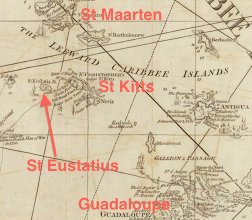
Leeward Caribbean islands with St. Maarten, St. Eustatius, St. Kitts and
Guadaloupe
(part of map from 1775 by T.Jefferys).
Ancestry of Adrienne Heyliger (* 1764)
| AS VI.86 to overview | |||||||||||||||||||
|
|
|
| ||||||||||||||||
|
| ||||||||||||||||||
| |||||||||||||||||||
Adrienne/Adriana Heyliger |
|||||||||||||||||||
|
|
Information on this page has been foremost taken
from
The Heyliger Family
and
Tribalpages.com Heyliger.
The oldest known Heyliger in relation with St. Eustatius is Guilliam Heyliger.
Numerous Heyliger descendants emigrated later to the U.S.A.
Guilliam Heyliger and Anna Ryckwaert
Guilliam Heyliger was on St. Eustatius by about 1670 when he married Anna Ryckwaert. Mathieu Ryckwaert, one of the first settlers on St. Eustatius in 1636, may have been Anna's grandfather. In view of the name of the original settlement company it is thus likely that both Guilliam Heyliger and Mathieu Ryckwaert came from the Dutch province of Zeeland (or nearby Flanders or Brabant).
Children: 1. Nicolaas Heyliger (has descendants); 2. Jannus (Jan) Heyliger (has desc.); 3. Pieter Heyliger (has desc.); 4. Guilliaem Heyliger (has desc.); 5. Johannes (Joannis) Heyliger (has desc.); 6. Francina Heyliger (x Pieter Hendriks); 7. Anna Heyliger (x Lodewijk Aertsen/Aertsz); 8. Abraham Heyliger (x Maria Salomonsz); 9. Catharina Heyliger (x Theodorus Ketterling); 10. Janneke Heyliger (x Jan Hendriks); 11. Maria Heyliger.
Guilliam Sr. traveled in 1705 to St. Maarten with 2 sons and 5 daughters and shortly after 1720 established there with his family. Guilliam apparently owned on St. Martin a small plantation and lived on the Dutch part of the island (the other part was French) with only 11 male adults as of August 19th 1715. It seems from his last will and testament of October 10th 1732 to which he legalised to the Calvinistic Church on St Maarten, he willed 2 pieces of Eight (Spanish Pesos or Half Crowns), and to Maria his youngest daughter, a little coloured girl named Betsy and a cow, while he requested by the distribution of the inheritance to give her custody of the slave Lena, with family. He signed "Guilliam Heyliger, Sr." while as witnesses signed Guilliam Heyliger Sr. and Alraham Halman. (From "Heyliger Family".)
The Europeans on St. Eustatius foremost exploited sugar plantations. These were worked by slaves. The numer of slaves has been studied and some information can be gleaned from the slave situation in about 1775 at the plantation of William Moore (x Adriana Heyliger) and his uncle Abraham Heyliger.
Abraham and Maria
Both were from St. Eustatius
Children:
1. Abraham (x Adriana Raapzaat);
2. Johannes Heyliger;
3. Maria Heyliger (18/6/1719-18/1/1724, St. Eust.).
Census 1746 St. Eustatius: "Abraham Heyliger Sen.r".
He was married and owned
8 male, 4 female and 2 boy slaves; no children are
mentioned, they must have left the house.
Census 1758: the couple is not mentioned, they probably have died.
Abraham and Adriana Raapzaat
Both are from St. Eustatius,
the marriage date has been taken from "vifamilies.org".
The Raapzaat family goes back to Lucas Jacob Raapzaat, Dutch Commander
of St. Eustatius and Saba (17th century).
Willem Stuyvesant's son, Balthasar Stuyvesant (1647-1678),
settled on St. Eustatius and married Maria Lucas Raapzaat.
Census 1746 St. Eustatius:
"De Weed. Jane Lucas Raapzaat"; is this Adriana's mother?
She owned 12 male, 8 female, and 8 boy slaves.
The census of 1758 as well as 1766 mentions "Engel Raapzaat";
is this a brother of Adriana?
Children:
1. Abraham Heyliger (has descendants);
2. Willem Heyliger (has descendants);
3. Maria Heyliger (Markoe) (x Jaycobus Seys, St. Eust.);
4. Johannes (x Elizabeth Molineux);
5. 1740 Raapzaet Heyliger (x Aletta Heyliger, St. Maarten);
6. Jacobus Heyliger (14/1/1744- died young, St. Croix);
7. Nicolaas Heyliger (x Johanna Salomons, St. Eust.);
8. Pieter Heyliger (1/10/1750-27/2/1779, St. Eust.).
[Dates are as given on the website of the Heyliger family.]
In census of 1766: Johannes Heyliger AbZ,
Nicolaas Heyliger Abs.Z,
Wm Heyliger Abz and Pieter Heyliger Abs.Z.
Johannes and Elizabeth
Elizabeth was from the island St. Kitts.
Census 1766 St. Eustatius: Johannes Heyliger AbZ, he is married,
has 3 sons, 4 daughters,
and owns 10 male, 5 female and 5 boy slaves.
Children: 1. Abraham Heyliger (1761-1792, St. Eust);
2. Adriana Heyliger (x William Moore, St. Eust);
3. John Laval Heyliger (1765-1792, Montserrat);
4. William Lucas Heyliger (1769-1794, Montserrat).
Elizabeth married again: 1780 Charles Haggart, 1791 member of the firm
Charles & Robert Haggart of St. Thomas.
She lived 1810 with him on his estate
Banteskine at Falkirk, Stirlingshsire, Scotland.
Her will and inventory
(she died 1821 Molineux Cottage, Polmont, Scotland) exist in the
"Scottish Record Office" Edinburgh under nr.S.C. 67/36/5, p.466.
The total value of what she left was £ 21,413.6.
Census St Eustatius 1748 Census St Eustatius 1758 Census St Eustatius 1766
(2017.04.15)